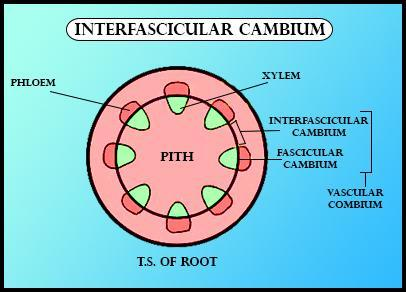
Interfascicular cambium is situated.
(a) Between xylem and phloem
(b) Between vascular bundles
(c) Outside the vascular bundles
(d) Inner side of the vascular bundles
Answer
473.7k+ views
Hint: During secondary growth, the medullary rays adjacent to the intrafascicular cambium become meristematic tissue and are called interfascicular cambium active cambial ring initiates differentiation of the latest cells; numerous cells are formed towards the center and periphery regions Interfascicular cambium is a secondary meristem.
Complete answer:
The vascular cambium is the meristem that produces secondary xylem and phloem in stems and roots of gymnosperms, woody dicots, and, to a limited extent, some herbaceous dicots. It differentiates from the procambium, the progenitor of the primary xylem and phloem, within vascular bundles. In elongating shoots, the differentiation of the cambium in a vascular bundle starts at the stem base and proceeds acropetally, occurring in a particular stem portion as its elongation ceases. Within a vascular bundle, the procambium and the cambium exist as a developmental continuum. Consequently, the transition from primary xylem to secondary xylem cannot be precisely delimited.

The cambium found within vascular bundles is denoted the fascicular cambium. Subsequently, in the transverse plane, periclinal divisions occur in the interfascicular parenchyma cells located at the edges of the fascicular cambium, and the interfascicular cambium is initiated.
So, the correct answer is ‘(b) Between vascular bundles’.
Additional Information: The initiation of the interfascicular cambium progresses laterally until the interfascicular cambia originating from two adjacent vascular bundles connect. Ultimately, a continuous ring of vascular cambium is formed within the stem and, with the production of additional vascular tissue, the fascicular and interfascicular cambia become indistinguishable. In some members of plants, vascular cambium is made from the outer region of the bottom tissues like Dracaena, yucca, Agave, Aloe arborescens, Lomandra, Kingia, Sansevieria, etc. Parenchyma formed towards the surface by the vascular cambium and secondary vascular bundles is formed toward the inner side.
Note: The interfascicular cambium usually does not develop in stems exhibiting little fascicular cambial activity. In such stems, other cells specialized for support are formed. For example, in Arabidopsis thaliana.
Complete answer:
The vascular cambium is the meristem that produces secondary xylem and phloem in stems and roots of gymnosperms, woody dicots, and, to a limited extent, some herbaceous dicots. It differentiates from the procambium, the progenitor of the primary xylem and phloem, within vascular bundles. In elongating shoots, the differentiation of the cambium in a vascular bundle starts at the stem base and proceeds acropetally, occurring in a particular stem portion as its elongation ceases. Within a vascular bundle, the procambium and the cambium exist as a developmental continuum. Consequently, the transition from primary xylem to secondary xylem cannot be precisely delimited.

The cambium found within vascular bundles is denoted the fascicular cambium. Subsequently, in the transverse plane, periclinal divisions occur in the interfascicular parenchyma cells located at the edges of the fascicular cambium, and the interfascicular cambium is initiated.
So, the correct answer is ‘(b) Between vascular bundles’.
Additional Information: The initiation of the interfascicular cambium progresses laterally until the interfascicular cambia originating from two adjacent vascular bundles connect. Ultimately, a continuous ring of vascular cambium is formed within the stem and, with the production of additional vascular tissue, the fascicular and interfascicular cambia become indistinguishable. In some members of plants, vascular cambium is made from the outer region of the bottom tissues like Dracaena, yucca, Agave, Aloe arborescens, Lomandra, Kingia, Sansevieria, etc. Parenchyma formed towards the surface by the vascular cambium and secondary vascular bundles is formed toward the inner side.
Note: The interfascicular cambium usually does not develop in stems exhibiting little fascicular cambial activity. In such stems, other cells specialized for support are formed. For example, in Arabidopsis thaliana.
Recently Updated Pages
Glucose when reduced with HI and red Phosphorus gives class 11 chemistry CBSE

The highest possible oxidation states of Uranium and class 11 chemistry CBSE

Find the value of x if the mode of the following data class 11 maths CBSE

Which of the following can be used in the Friedel Crafts class 11 chemistry CBSE

A sphere of mass 40 kg is attracted by a second sphere class 11 physics CBSE

Statement I Reactivity of aluminium decreases when class 11 chemistry CBSE

Trending doubts
The reservoir of dam is called Govind Sagar A Jayakwadi class 11 social science CBSE

Proton was discovered by A Thomson B Rutherford C Chadwick class 11 chemistry CBSE

What is the chemical name of Iron class 11 chemistry CBSE

The dimensional formula of dielectric strength A M1L1T2Q class 11 physics CBSE

The members of the Municipal Corporation are elected class 11 social science CBSE

Number of oneone functions from A to B where nA 4 and class 11 maths CBSE




